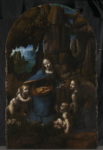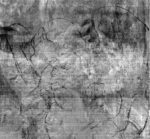 Researchers at London’s National Gallery have identified original drawings by Leonardo da Vinci under The Virgin of the Rocks. An earlier examination of the work in 2004/5 had found changes to the Virgin’s pose. Vague indicators of other figures in the composition were thought to be line changes between the original pose and the final one. A new analysis using the latest imaging technology revealed there were two compositions under the painting. In the initial design, the angel and Christ child were markedly different than they turned out to be in the end.
Researchers at London’s National Gallery have identified original drawings by Leonardo da Vinci under The Virgin of the Rocks. An earlier examination of the work in 2004/5 had found changes to the Virgin’s pose. Vague indicators of other figures in the composition were thought to be line changes between the original pose and the final one. A new analysis using the latest imaging technology revealed there were two compositions under the painting. In the initial design, the angel and Christ child were markedly different than they turned out to be in the end.
In the abandoned composition both figures are positioned higher up, while the angel, facing out, is looking down on the Infant Christ with what appears to be a much tighter embrace. These new images were found because the drawings were made in a material that contained some zinc, so it could be seen in the macro x-ray fluorescence (MA-XRF) maps showing where this chemical element was present, and also through new infrared and hyperspectral imaging.
Why Leonardo abandoned this first composition still remains a mystery. The new research has shown how the second underdrawing, while aligning much more closely to the finished version, nonetheless displays his characteristic elaborations and adjustments from drawing to painting. For instance, the angle of the Infant Christ’s head was changed so that he was seen in profile, while some parts of the angel’s curly hair have been removed. Handprints resulting from patting down the priming on the panel to create an even layer of more or less uniform thickness can also be seen, probably the work of an assistant – but perhaps even by Leonardo himself.
 It’s a particularly intriguing find given the complicated history behind the composition of the piece. Commissioned in 1483 by the Confraternity of the Immaculate Conception for their chapel abutting the Church of San Francesco Grande in Milan, the painting as originally envisaged by the confraternity was a traditional Renaissance view of the Immaculate Conception — Mary, angels, an architectural setting — but Leonardo instead went his own way, creating a rocky, humid, cave-like setting and depicting the Virgin, the Christ Child and John the Baptist. This was his first commission in Milan; you’d think he might try to please his clients instead of blowing them off in favor of his own vision. The result caused some consternation among the confraternity and when Leonardo did not get paid the full amount, he sold the painting to a private buyer. That first version of the Virgin on the Rocks is now at the Louvre.
It’s a particularly intriguing find given the complicated history behind the composition of the piece. Commissioned in 1483 by the Confraternity of the Immaculate Conception for their chapel abutting the Church of San Francesco Grande in Milan, the painting as originally envisaged by the confraternity was a traditional Renaissance view of the Immaculate Conception — Mary, angels, an architectural setting — but Leonardo instead went his own way, creating a rocky, humid, cave-like setting and depicting the Virgin, the Christ Child and John the Baptist. This was his first commission in Milan; you’d think he might try to please his clients instead of blowing them off in favor of his own vision. The result caused some consternation among the confraternity and when Leonardo did not get paid the full amount, he sold the painting to a private buyer. That first version of the Virgin on the Rocks is now at the Louvre.
 Ten years later, Leonardo began working on a second version, likely because the confraternity paid its balance. It was the exact same dimension (the arch-shaped frame was already made, after all) and the same subject, but with notable differences in composition and palette. The newly-discovered underdrawings are certainly in his hand, which is not the case for the application of the paint itself, so they uniquely show the false starts and evolution of Leonardo’s vision for the work.
Ten years later, Leonardo began working on a second version, likely because the confraternity paid its balance. It was the exact same dimension (the arch-shaped frame was already made, after all) and the same subject, but with notable differences in composition and palette. The newly-discovered underdrawings are certainly in his hand, which is not the case for the application of the paint itself, so they uniquely show the false starts and evolution of Leonardo’s vision for the work.
 Starting November 9, 2019, the National Gallery will host a new exhibition centered around The Virgin of the Rocks. Leonardo: Experience a Masterpiece takes an innovative approach to give visitors an immersive experience into the context of the painting and of its creator.
Starting November 9, 2019, the National Gallery will host a new exhibition centered around The Virgin of the Rocks. Leonardo: Experience a Masterpiece takes an innovative approach to give visitors an immersive experience into the context of the painting and of its creator.
A wide range of multi-sensory experiences will be presented across four separate rooms. Visitors will be able to step inside a similar chapel setting and see what art historical research suggests the painting’s setting may have looked like. They will be able to explore Leonardo’s own research, which informed the specific compositions in the painting. In addition they will see how Leonardo used his scientific studies to create strong effects of light and shadow in his painting. The modern process of discovery in a conservation studio, where the mysteries and secrets of a painting are uncovered, will also be brought to life with visitors being able to engage in detail with the latest findings underneath ‘The Virgin of the Rocks’.
Like a virgin on the Rocks,
Fingerprinted for the very first time
Like a virgin on the Rocks,
When your heart rocks next to mine
:boogie:
——-
A scroll with words “Ecce Agnus Dei” is one of John the Baptist’s attribute. Here, however, the text is seemingly a slightly a longer one. Thus, the ‘lamb’ of the Lord is obviously not only the one of the Lord. Notably, the later abandoned composition would have been totally out of proportion, at least that bit does not really seem to be a mystery. What is written on the end of that scroll that John is holding? :confused:
“Agnus Dei, qui tolis peccata mundi” is the full quote. Usually translated as “Behold the lamb of god that takes away the sins of the world.” I do not see this dialog scroll in this version. Is it in the other one?
Thanks Scott, in case you put an “ECCE” in front (i.e. ‘behold’), I reckon, it makes perfect sense.
Look again, it is indeed in the very first picture. On the left, John is holding a rather brownish tape (cloth?, leather?) with letters on it. It even says, ‘Ecce Agnus..”, but the rest had been unreadable to me.
Maybe, put on more light, and maybe look at it from a different angle. It is indeed all rather brownish, with the blue dress as background.
Thanks again!
Thank you for locating the dialogue scroll for me but I still cannot make it out. I had a bit of vision loss in the last two years by way of explanation not sympathy seeking. Makes for some typos and autocorrect issues. While looking for the other version I ran across an article by an Italian art historian, Silvano Vinceti who pointed out a dog with a leash is shown in the rocks above the Virgin. (I also cannot make it out.) It is related to a known Leonardo drawing and said to be a criticism of the current pope at the time. Leonardo was often in conflict with his patrons (So was Michelangelo.)and was pushing the envelope so to speak in regard to how he showed traditional religious iconography. In the the Virgin and Saint Anne he had a dispute with the patrons over halos. He ultimately had a studio produced copy made with the halos by his students for the patrons. His version of the madonna in the Hermitage shows her as a teenager (more likely accurate) than a mature woman as most representations of the Virgin require. Some claim he even produced the Shroud of Turin. I found the narcissus and the other flowers I cannot identify at the bottom interesting. Every things has meaning. Narcissus are associated both with renewal and rebirth and Lent. So they re-enforce the cross held by little Saint John.
Let us leave no rock unturned.
Is that the puppy lower right, just above the grass-tuft?
…those “lumps”, Watson, they do indeed look like puppy droppings 😮
—————
Maybe petrified ones, in this special case?
While everything has meaning, I find that as an artist that there is always more meaning than one intentionally puts into a work. We are programmed by society in general to believe in sets of assumptions that we mostly never notice – unless we go and live in another, rather different society. I sometimes listen to people talking about my work, and often it is like they are talking about some other work by a different artist. On the other hand, when I talk about some aspects of my work, the listeners are somewhat surprised because their assumptions have blocked them from seeing what I intended to show.
So, what Leonardo intended to show could be right there in front of us, and none of us can see it.
Rajput Dynasty